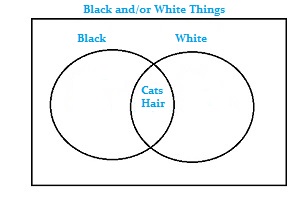If You Know P(a) and P(B) How Do You Calculate P(a and B)
Sentry the video for a few quick examples of how to find the Probability of A and B / A or B:
Probability of A or B (also A and B)
Can't encounter the video? Click here.
You may desire to read this article kickoff: Dependent or Independent Event? How to Tell the Difference.
- Probability of A and B.
- Probability of A or B.

A Venn diagram intersection shows events a and b happening together.
1. What is the Probability of A and B?
The probability of A and B means that we want to know the probability of two events happening at the same time. There'south a couple of unlike formulas, depending on if you accept dependent events or independent events.
Formula for the probability of A and B (independent events): p(A and B) = p(A) * p(B).
If the probability of one issue doesn't bear upon the other, you have an independent outcome. All you lot practise is multiply the probability of one by the probability of another.
Examples
Example 1: The odds of you getting promoted this year are 1/4. The odds of y'all being audited by the IRS are about 1 in 118. What are the odds that you get promoted and you get audited by the IRS?
Solution:
Stride 1: Multiply the ii probabilities together:
p(A and B) = p(A) * p(B) = 1/iv * ane/118 = 0.002.
That's information technology!
Example ii: The odds of it raining today is 40%; the odds of you getting a pigsty in one in golf are 0.08%. What are your odds of it raining and you getting a hole in one?
Solution:
Stride i: Multiply the probability of A by the probability of B.
p(A and B) = p(A) * p(B) = 0.iv * 0.0008 = 0.00032.
That'south it!
Formula for the probability of A and B (dependent events): p(A and B) = p(A) * p(B|A)
The formula is a little more complicated if your events are dependent, that is if the probability of 1 event effects another. In order to figure these probabilities out, you lot must find p(B|A), which is the conditional probability for the event.
Example question: You have 52 candidates for a committee. 4 are persons aged 18 to 21. If you randomly select one person, and so (without replacing the first person's name), randomly select a second person, what is the probability both people will be between 18 and 21 years old?
Solution:
Step 1: Effigy out the probability of choosing an 18 to 21 yr old on the get-go depict. As there are 52 possibilities, and 4 are aged 18 to 21, you lot have a iv/52 = i/13 chance.
Step 2: Figure out p(B|A), which is the probability of the next consequence (choosing a second person aged 18 to 21) given that the first event in Step 1 has already happened.
There are 51 people left, and only 3 are aged 18 to 21 now, and so the probability of choosing a young adult again is 3/51 = 1 / 17.
Step 3: Multiply your probabilities from Footstep 1(p(A)) and Footstep 2(p(B|A)) together:
p(A) * p(B|A) = i/13 * 1/17 = 1/221.
Your odds of choosing two people aged xviii to 21 are 1 out of 221.
2. What is the Probability of A or B?
The probability of A or B depends on if you accept mutually sectional events (ones that cannot happen at the same time) or not.
If ii events A and B are mutually exclusive, the events are called disjoint events. The probability of two disjoint events A or B happening is:
p(A or B) = p(A) + p(B).
Example question: What is the probability of choosing one card from a standard deck and getting either a Queen of Hearts or Ace of Hearts? Since y'all tin can't become both cards with ane depict, add together the probabilities:
P(Queen of Hearts or Ace of Hearts) = p(Queen of Hearts) + p(Ace of Hearts) = ane/52 + 1/52 = 2/52.
If the events A and B are not mutually exclusive, the probability is:
(A or B) = p(A) + p(B) – p(A and B).
Case question: What is the probability that a carte du jour chosen from a standard deck volition be a Jack or a eye?
Solution:
- p(Jack) = 4/52
- p(Heart) = xiii/52
- p(Jack of Hearts) = one/52
So:
p(Jack or Centre) = p(Jack) + p(Heart) – p(Jack of Hearts) = 4/52 + thirteen/52 – 1/52 = 16/52.
References
Salkind, N. (2019). Statistics for People Who (Think They) Hate Statistics 7th Edition. SAGE.
---------------------------------------------------------------------------
Need help with a homework or examination question? With Chegg Study, you can get pace-by-pace solutions to your questions from an expert in the field. Your first thirty minutes with a Chegg tutor is complimentary!
Comments? Need to postal service a correction? Delight mail service a comment on our Facebook folio .
Source: https://www.statisticshowto.com/probability-and-statistics/probability-main-index/probability-of-a-and-b/#:~:text=probability%20of%20B.-,p(A%20and%20B),That's%20it!&text=The%20formula%20is%20a%20little,of%20one%20event%20effects%20another.
0 Response to "If You Know P(a) and P(B) How Do You Calculate P(a and B)"
Postar um comentário